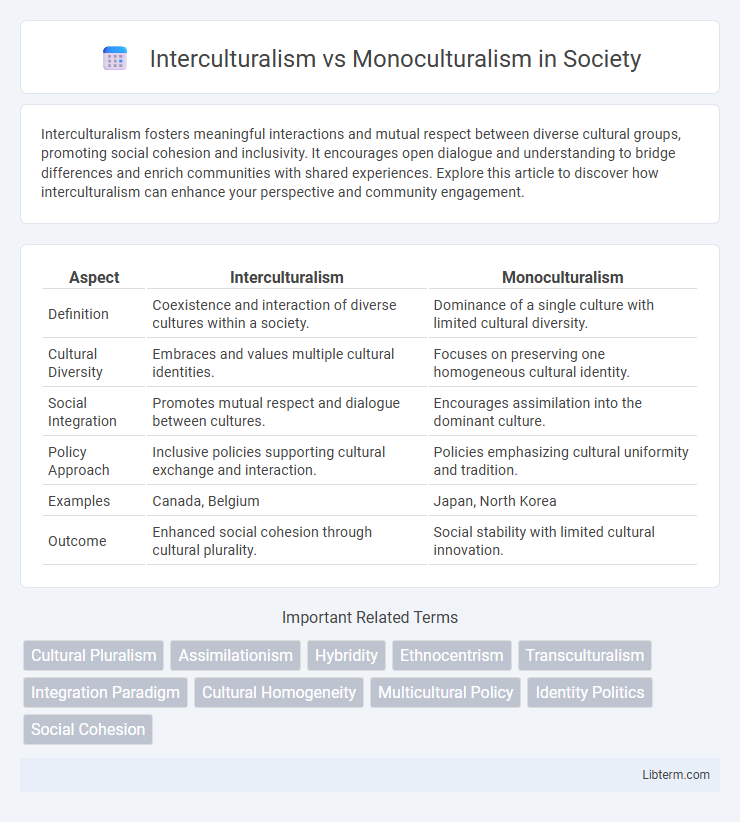Interculturalism fosters meaningful interactions and mutual respect between diverse cultural groups, promoting social cohesion and inclusivity. It encourages open dialogue and understanding to bridge differences and enrich communities with shared experiences. Explore this article to discover how interculturalism can enhance your perspective and community engagement.
Table of Comparison
| Aspect | Interculturalism | Monoculturalism |
|---|---|---|
| Definition | Coexistence and interaction of diverse cultures within a society. | Dominance of a single culture with limited cultural diversity. |
| Cultural Diversity | Embraces and values multiple cultural identities. | Focuses on preserving one homogeneous cultural identity. |
| Social Integration | Promotes mutual respect and dialogue between cultures. | Encourages assimilation into the dominant culture. |
| Policy Approach | Inclusive policies supporting cultural exchange and interaction. | Policies emphasizing cultural uniformity and tradition. |
| Examples | Canada, Belgium | Japan, North Korea |
| Outcome | Enhanced social cohesion through cultural plurality. | Social stability with limited cultural innovation. |
Understanding Interculturalism and Monoculturalism
Interculturalism promotes the interaction and integration of diverse cultural groups within a society, fostering mutual respect and shared values to enhance social cohesion. Monoculturalism emphasizes the preservation of a single dominant culture, encouraging uniformity and cultural homogeneity to maintain national identity. Understanding these concepts involves recognizing interculturalism's role in facilitating inclusion and adaptability, while monoculturalism supports tradition and cultural continuity.
Historical Evolution of Cultural Models
Interculturalism has evolved historically as a response to the limitations of monoculturalism, promoting dialogue, mutual respect, and integration among diverse cultural groups. Monoculturalism, dominant in earlier historical periods, emphasizes the preservation of a single cultural identity often linked to nation-states, leading to exclusionary practices. The shift toward intercultural models reflects global migration trends, colonial histories, and increasing recognition of multicultural societies in policy frameworks and social theories.
Key Characteristics of Interculturalism
Interculturalism emphasizes active dialogue, mutual respect, and the dynamic exchange between diverse cultural groups, fostering social cohesion while valuing both unity and cultural diversity. It promotes integration through shared public spaces and common values, contrasting with monoculturalism's focus on uniform cultural norms and assimilation. This approach supports inclusivity, adaptability, and the recognition of multiple identities within a pluralistic society.
Defining Features of Monocultural Societies
Monocultural societies are characterized by a predominant single culture, language, and set of traditions that shape social norms and institutions uniformly. These societies often emphasize cultural homogeneity, maintaining a strong sense of national identity and community cohesion through shared values and practices. Social integration in monocultural environments typically limits exposure to diverse cultural perspectives, affecting adaptability in globalized contexts.
Benefits of Embracing Interculturalism
Interculturalism fosters mutual respect and understanding among diverse cultural groups, enhancing social cohesion and reducing conflicts. Embracing interculturalism promotes innovation and creativity by integrating different perspectives and knowledge systems, benefiting workplaces and communities. This approach also supports inclusive policies that improve access to education, healthcare, and economic opportunities for marginalized populations, driving equitable development.
Challenges in Monocultural Environments
Monocultural environments often face challenges such as limited perspectives, reduced creativity, and difficulties in adapting to global markets. These environments tend to foster homogeneity, which can hinder innovation and exclude diverse viewpoints essential for problem-solving and growth. Social tensions and misunderstandings may also arise due to a lack of cultural awareness and inclusivity.
Social Integration and Community Building
Interculturalism promotes social integration by encouraging dialogue and interaction among diverse cultural groups, fostering mutual understanding and respect within communities. This approach enhances community building by recognizing and valuing cultural differences as assets, which helps reduce social fragmentation and conflict. In contrast, monoculturalism often prioritizes uniformity and assimilation, potentially leading to exclusion and weakening social cohesion by marginalizing minority identities.
Economic Impacts of Cultural Diversity
Cultural diversity fosters innovation and economic growth by bringing diverse perspectives that enhance problem-solving and creativity in global markets. Interculturalism promotes inclusive policies that increase workforce adaptability and access to international trade opportunities, driving higher productivity and competitiveness. In contrast, monoculturalism risks economic stagnation by limiting talent pools and reducing the ability to effectively engage in the global economy.
Common Misconceptions about Each Model
Interculturalism is often misunderstood as merely blending cultures into a homogeneous mix, while monoculturalism is incorrectly seen solely as cultural isolation without acknowledging its reinforcement of dominant cultural norms. Critics of interculturalism sometimes assume it diminishes cultural identities, yet it promotes respectful coexistence and dialogue among diverse groups. Similarly, monoculturalism is frequently viewed as preserving tradition, but it can marginalize minority cultures by prioritizing a single cultural framework.
The Future of Cultural Interaction in a Globalized World
Interculturalism emphasizes the dynamic exchange and mutual enrichment between diverse cultural groups, fostering collaboration and innovation essential for global progress. Monoculturalism tends to prioritize a single dominant culture, which can limit adaptive capabilities in an increasingly interconnected world. The future of cultural interaction depends on embracing interculturalism to navigate complex global challenges and promote sustainable social cohesion.
Interculturalism Infographic

 libterm.com
libterm.com